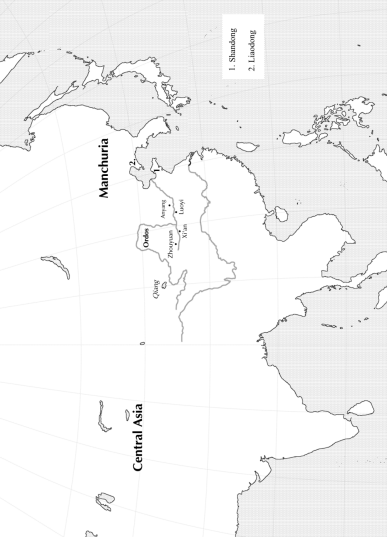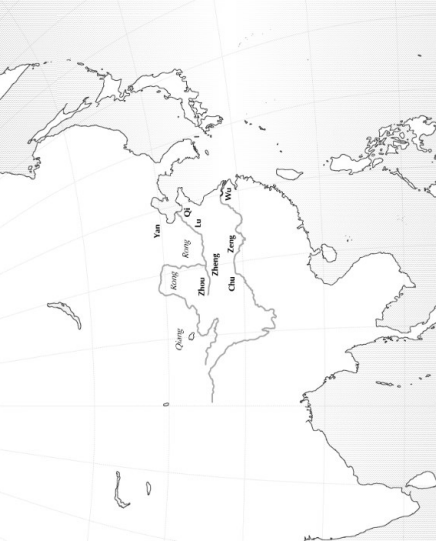2.1: A Violent Transition
- Page ID
- 135105
\( \newcommand{\vecs}[1]{\overset { \scriptstyle \rightharpoonup} {\mathbf{#1}} } \)
\( \newcommand{\vecd}[1]{\overset{-\!-\!\rightharpoonup}{\vphantom{a}\smash {#1}}} \)
\( \newcommand{\id}{\mathrm{id}}\) \( \newcommand{\Span}{\mathrm{span}}\)
( \newcommand{\kernel}{\mathrm{null}\,}\) \( \newcommand{\range}{\mathrm{range}\,}\)
\( \newcommand{\RealPart}{\mathrm{Re}}\) \( \newcommand{\ImaginaryPart}{\mathrm{Im}}\)
\( \newcommand{\Argument}{\mathrm{Arg}}\) \( \newcommand{\norm}[1]{\| #1 \|}\)
\( \newcommand{\inner}[2]{\langle #1, #2 \rangle}\)
\( \newcommand{\Span}{\mathrm{span}}\)
\( \newcommand{\id}{\mathrm{id}}\)
\( \newcommand{\Span}{\mathrm{span}}\)
\( \newcommand{\kernel}{\mathrm{null}\,}\)
\( \newcommand{\range}{\mathrm{range}\,}\)
\( \newcommand{\RealPart}{\mathrm{Re}}\)
\( \newcommand{\ImaginaryPart}{\mathrm{Im}}\)
\( \newcommand{\Argument}{\mathrm{Arg}}\)
\( \newcommand{\norm}[1]{\| #1 \|}\)
\( \newcommand{\inner}[2]{\langle #1, #2 \rangle}\)
\( \newcommand{\Span}{\mathrm{span}}\) \( \newcommand{\AA}{\unicode[.8,0]{x212B}}\)
\( \newcommand{\vectorA}[1]{\vec{#1}} % arrow\)
\( \newcommand{\vectorAt}[1]{\vec{\text{#1}}} % arrow\)
\( \newcommand{\vectorB}[1]{\overset { \scriptstyle \rightharpoonup} {\mathbf{#1}} } \)
\( \newcommand{\vectorC}[1]{\textbf{#1}} \)
\( \newcommand{\vectorD}[1]{\overrightarrow{#1}} \)
\( \newcommand{\vectorDt}[1]{\overrightarrow{\text{#1}}} \)
\( \newcommand{\vectE}[1]{\overset{-\!-\!\rightharpoonup}{\vphantom{a}\smash{\mathbf {#1}}}} \)
\( \newcommand{\vecs}[1]{\overset { \scriptstyle \rightharpoonup} {\mathbf{#1}} } \)
\( \newcommand{\vecd}[1]{\overset{-\!-\!\rightharpoonup}{\vphantom{a}\smash {#1}}} \)
\(\newcommand{\avec}{\mathbf a}\) \(\newcommand{\bvec}{\mathbf b}\) \(\newcommand{\cvec}{\mathbf c}\) \(\newcommand{\dvec}{\mathbf d}\) \(\newcommand{\dtil}{\widetilde{\mathbf d}}\) \(\newcommand{\evec}{\mathbf e}\) \(\newcommand{\fvec}{\mathbf f}\) \(\newcommand{\nvec}{\mathbf n}\) \(\newcommand{\pvec}{\mathbf p}\) \(\newcommand{\qvec}{\mathbf q}\) \(\newcommand{\svec}{\mathbf s}\) \(\newcommand{\tvec}{\mathbf t}\) \(\newcommand{\uvec}{\mathbf u}\) \(\newcommand{\vvec}{\mathbf v}\) \(\newcommand{\wvec}{\mathbf w}\) \(\newcommand{\xvec}{\mathbf x}\) \(\newcommand{\yvec}{\mathbf y}\) \(\newcommand{\zvec}{\mathbf z}\) \(\newcommand{\rvec}{\mathbf r}\) \(\newcommand{\mvec}{\mathbf m}\) \(\newcommand{\zerovec}{\mathbf 0}\) \(\newcommand{\onevec}{\mathbf 1}\) \(\newcommand{\real}{\mathbb R}\) \(\newcommand{\twovec}[2]{\left[\begin{array}{r}#1 \\ #2 \end{array}\right]}\) \(\newcommand{\ctwovec}[2]{\left[\begin{array}{c}#1 \\ #2 \end{array}\right]}\) \(\newcommand{\threevec}[3]{\left[\begin{array}{r}#1 \\ #2 \\ #3 \end{array}\right]}\) \(\newcommand{\cthreevec}[3]{\left[\begin{array}{c}#1 \\ #2 \\ #3 \end{array}\right]}\) \(\newcommand{\fourvec}[4]{\left[\begin{array}{r}#1 \\ #2 \\ #3 \\ #4 \end{array}\right]}\) \(\newcommand{\cfourvec}[4]{\left[\begin{array}{c}#1 \\ #2 \\ #3 \\ #4 \end{array}\right]}\) \(\newcommand{\fivevec}[5]{\left[\begin{array}{r}#1 \\ #2 \\ #3 \\ #4 \\ #5 \\ \end{array}\right]}\) \(\newcommand{\cfivevec}[5]{\left[\begin{array}{c}#1 \\ #2 \\ #3 \\ #4 \\ #5 \\ \end{array}\right]}\) \(\newcommand{\mattwo}[4]{\left[\begin{array}{rr}#1 \amp #2 \\ #3 \amp #4 \\ \end{array}\right]}\) \(\newcommand{\laspan}[1]{\text{Span}\{#1\}}\) \(\newcommand{\bcal}{\cal B}\) \(\newcommand{\ccal}{\cal C}\) \(\newcommand{\scal}{\cal S}\) \(\newcommand{\wcal}{\cal W}\) \(\newcommand{\ecal}{\cal E}\) \(\newcommand{\coords}[2]{\left\{#1\right\}_{#2}}\) \(\newcommand{\gray}[1]{\color{gray}{#1}}\) \(\newcommand{\lgray}[1]{\color{lightgray}{#1}}\) \(\newcommand{\rank}{\operatorname{rank}}\) \(\newcommand{\row}{\text{Row}}\) \(\newcommand{\col}{\text{Col}}\) \(\renewcommand{\row}{\text{Row}}\) \(\newcommand{\nul}{\text{Nul}}\) \(\newcommand{\var}{\text{Var}}\) \(\newcommand{\corr}{\text{corr}}\) \(\newcommand{\len}[1]{\left|#1\right|}\) \(\newcommand{\bbar}{\overline{\bvec}}\) \(\newcommand{\bhat}{\widehat{\bvec}}\) \(\newcommand{\bperp}{\bvec^\perp}\) \(\newcommand{\xhat}{\widehat{\xvec}}\) \(\newcommand{\vhat}{\widehat{\vvec}}\) \(\newcommand{\uhat}{\widehat{\uvec}}\) \(\newcommand{\what}{\widehat{\wvec}}\) \(\newcommand{\Sighat}{\widehat{\Sigma}}\) \(\newcommand{\lt}{<}\) \(\newcommand{\gt}{>}\) \(\newcommand{\amp}{&}\) \(\definecolor{fillinmathshade}{gray}{0.9}\)In the twelfth century BC, the Zhou people were one of the communities whom Shang alternately allied with and fought against. The later thinker Mencius called them “western barbarians.” They seem to have moved several times, and according to later written records, in about 1125, a leader named Danfu settled the Zhou people in the Wei River Valley to the west of Shang at a place called Zhouyuan (see Map C). His son Jili died in a battle against Shang in 1099, and Shang also captured Jili’s son Chang. When they released him, they gave him some bronze vessels, and entrusted him with guarding their western flank against a Central Asian group called the Qiang (who spoke languages related to Tibetan): very dangerous enemies who often appear in the oracle bones as human sacrifices.
As allies in the loose Shang political order, Chang and the Zhou people began to take on many aspects of the impressive Shang elite culture. They adopted 亞 ya-shaped Shang-style tombs, and Shang-style sets of bronze vessels. They used and eventually began to bury chariots as the Shang did. They made buildings of pounded earth, but they added tile roofs: a big improvement over wood or thatch. They did turtle-shell divinations – using a different shape of pre-drilled hollow from Shang – and began writing in Shang characters, but very small and in a careless style, with a different syntax. Turtle shell divination fragments excavated 30 miles west of today’s Xi’an record that Chang sacrificed to the Shang royal ancestors, including recently dead kings; and the Shang king visited the Zhou homeland. So both sides worked to maintain the alliance.
But Chang was ambitious. Taking on these Shang forms of culture made sense as a political strategy to increase his prestige and power among his own people and the other groups in that area. The Shang had developed an impressive rulership culture and had dominated others for hundreds of years. The things they made and the rituals they did, by this time, in themselves carried authority: they both symbolized and created power. In order to increase his own power, Chang took on those symbols. Zhou men also married or claimed to have married women from the Shang and even Xia royal families, to enhance their own legitimacy. In 1056, Chang renounced the alliance, took the title “King Wen,” and renewed Zhou attacks on Shang. Zhou military power rested on an alliance of a number of different tribes from the mountains and valleys around them. King Wen and other Zhou leaders had to work extremely hard to maintain their coalition, as we know from the speeches recorded in the Book of Documents.

The conquest of Shang was bloody and difficult. In about 1053 King Wen’s armies were directly threatening Anyang when he died. His son King Wu (Martial or Military King) mourned his father for three years, and then set out on a campaign eastward in the 12th month of 1046 BC. He arrived at the outskirts of Anyang in the first month of 1045, and there he and all the allied tribes of western mountains and valleys fought all the armies of the tribes and clans living on the eastern plains, the Shang and their allies. The battle on the field of Muye lasted for an entire day and into the night. Muye was a vicious battle: so many people were wounded and killed that heavy items like stone pestles were washed away in the blood (we are told). Once King Wu had defeated the Shang, Zhou leaders celebrated by killing about a hundred Shang aristocrats whom they had taken prisoner.
How do we know that the battle of Muye occurred in 1045 BC? Transmitted primary sources list the Xia, Shang, and Zhou kings in order; Sima Qian’s Shi ji put all but one of the Shang kings in the correct order, as the oracle bones – which he did not have – confirm. But no one knew exactly how long each early Zhou king had reigned until, in 1976, archaeologists excavated a group of Zhou bronze vessels with long inscriptions that together provided a complete relative chronology of the Zhou kings. Then all that was needed to know the absolute dates of each king was a starting point. Astronomers can calculate when events such as lunar and solar eclipses and planetary conjunctions occurred in the past, and like all ancient people the Shang and Zhou observed such events closely, and recorded some. By coordinating the relative royal chronology with astronomical events, historian David Nivison set the Zhou conquest at 1045.1 Particularly useful was the report in the transmitted sources that in the 41st year of the reign of King Wen, “The Five Planets gathered in [the constellation] Room.” This refers to a syzygy: all five visible planets lined up. In this case, the line pointed down towards a gap in the hills where the Zhou were settled.
As well as providing a definite date for the Zhou conquest, the syzygy also answers the questions: How did King Wen and King Wu come by the courage to take on those powerful Shang ancestors? How did they convince the allies to join them in a confederation against Shang? The courage came from their faith in a new god, imported from Central Asia: Heaven (Tian 天). This sky god was no-one’s ancestor. The Zhou also claimed divine ancestors, but each tribe had its own ancestors. Heaven, by contrast, was for all peoples – like the sun, moon, and stars. Zhou heard about this god from their neighbors further west. When all the planets lined up, for the first time in over 500 years, dramatically pointing right down at the Zhou homeland, it must have seemed as if the sky god was sending a message – an order: Heaven’s Mandate.
(Later propagandists and historians further developed this “Mandate of Heaven” ideology, and used it to legitimate dynasties and explain their rise and fall. Heaven selects a virtuous man to rule the world. As long as his descendants are personally virtuous and attend to ritual; listen to wise advisors; and assure the people secure lives and livelihoods, they will hold the throne with the approval of Heaven. But if a ruler becomes wicked, heedless, and extravagant, Heaven will first warn him with signs like earthquakes, comets and droughts, and eventually choose a new virtuous leader. Invented to justify the rebellion of the Zhou against the Shang, this ideology faded in Zhou times, was revived in the middle of the Han period, and lasted until at least 1911.)
With a new sense of mission, the Zhou leaders also had a powerful way to convince others to join in a full-scale attack on Shang. Everyone could see the sign in the sky. Before and after the conquest, Zhou leaders made speeches and songs hammering home the idea that a Heaven, a deity above all ancestors, supported them. They argued that when Xia became wicked, Heaven mandated Shang to conquer and replace it; and when Shang became wicked, Heaven chose Zhou. Eventually scribes incorporated the speeches into the Book of Documents, and the songs into the Book of Poetry. Whereas Shang power had rested on organized violence, Zhou added ideology – ideas that justify power. Over the years, with repetition, the propaganda story of Heaven’s support for the Zhou helped whitewash the bloody conquest.



